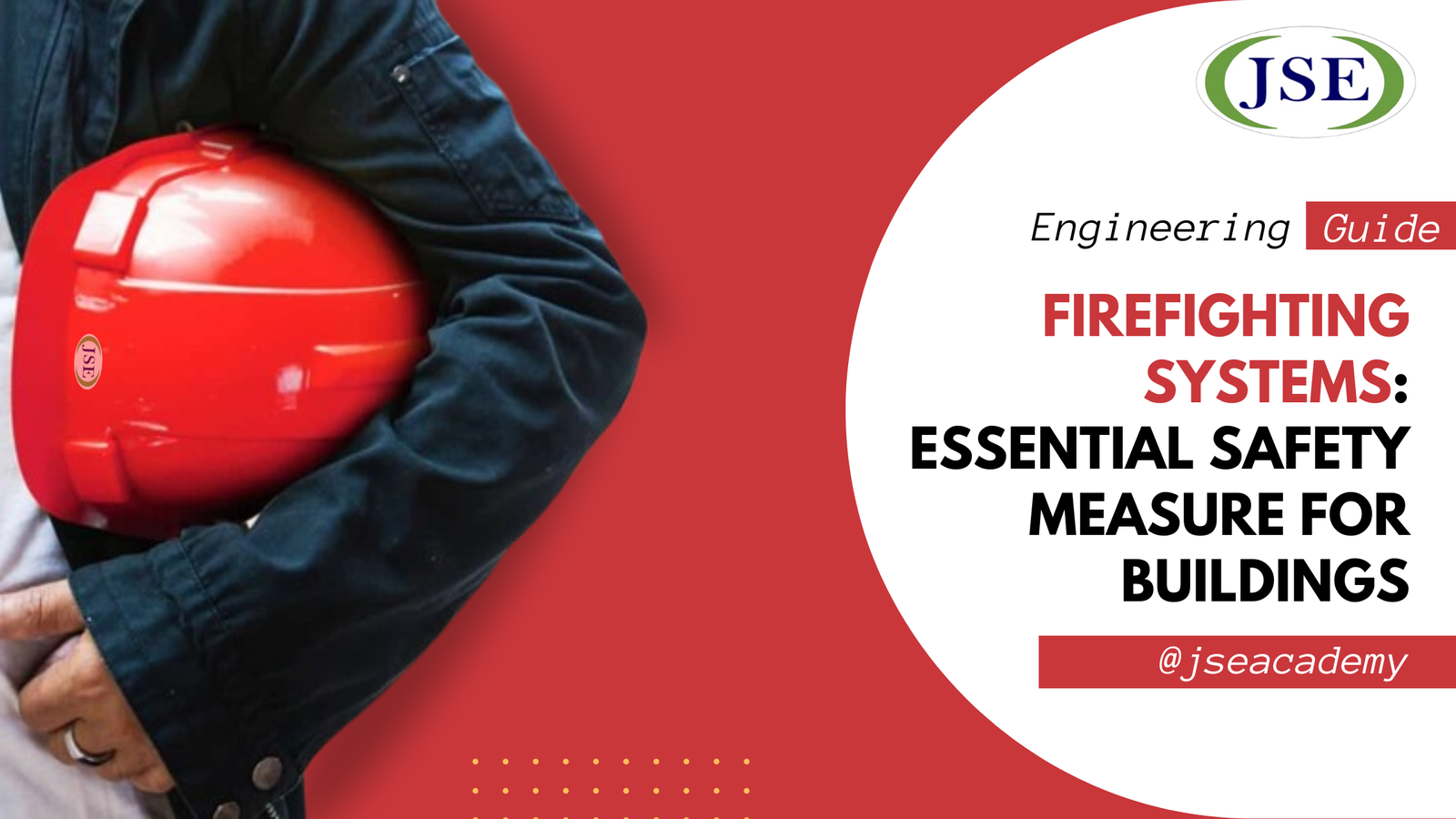Imagine this: You’re working on designing a skyscraper, everything looks perfect, the structure is solid, and the aesthetics are impressive, but there’s one critical system that could mean the difference between life and death—Firefighting Systems. In today’s world, safeguarding lives and property through well-designed firefighting systems is non-negotiable, and as an aspiring engineer, understanding these systems is key.
Let’s dive into the basics of firefighting systems and how they play a pivotal role in modern building safety, while also exploring how JSE Engineering Academy’s MEP courses can equip you with the skills needed to master these life-saving systems.
Why Are Firefighting Systems Essential?
Fire hazards can occur in any building—be it a home, office, or industrial facility. A well-designed firefighting system detects and controls fires before they spiral out of control. From fire sprinklers and alarms to extinguishers and smoke control systems, these technologies form the backbone of building safety.
Firefighting systems are built into the design of the building’s Mechanical, Electrical, and Plumbing (MEP) systems. That’s where engineers like you come in! You’ll ensure that every pipe, wire, and safety feature works together to protect the people inside.

Did You Know? Fire suppression systems like sprinklers reduce the risk of death in a fire by 80%. Sounds like something you’d want to be skilled in designing, right?
At JSE Engineering Academy, we offer courses in MEP design, which include everything from fire safety measures to advanced plumbing systems. These courses are designed to give you the tools to create smarter, safer buildings.
Key Components of Firefighting Systems
Fire Sprinkler Systems: These are some of the most effective tools for controlling fires. They activate automatically when they detect heat, dousing flames before they spread. As an engineer, you’ll need to know how to properly position, install, and maintain these systems.
Fire Alarms and Detectors: Early detection is critical. Smoke detectors and heat sensors are often part of an integrated fire alarm system that alerts occupants and emergency responders. Understanding the electrical integration of these systems is a crucial part of MEP design.
Standpipes and Fire Hoses: These systems allow firefighters to access water directly in the building, making it easier to control larger fires. Engineers must ensure standpipes are strategically placed and connected to the water supply.
Emergency Exits and Evacuation Routes: An often overlooked but critical aspect of fire safety is designing effective evacuation routes. As an engineer, you’ll work with architects to ensure that exits are easily accessible and free from obstacles.
Want to learn how to design these systems from scratch? Enroll in our specialized MEP courses at JSE Engineering Academy, where we’ll take you through hands-on software training like Revit MEP and AutoCAD MEP, helping you turn your knowledge into practical solutions.
You may also read: History and Guide to Plumbing System Engineering
How JSE Academy’s MEP Courses Prepare You for Fire Safety Design
You might wonder, “How do I go from student to professional design engineer, confidently designing firefighting systems?” It all starts with a solid understanding of MEP principles, and our academy is dedicated to helping you reach that level of expertise.

At JSE Engineering Academy, our MEP courses focus on real-world applications. You’ll learn:
3D Modeling with Revit MEP: Visualize and simulate firefighting systems in buildings.
Fire Safety Codes and Standards: Learn national and international regulations like NFPA (National Fire Protection Association) standards.
System Integration: Understand how fire safety integrates with HVAC, electrical systems, and building automation.
Our courses are designed to be interactive and practical—you won’t just learn theory, you’ll apply it. Plus, you’ll be working on industry-level projects, preparing you for a seamless transition into the workforce.
Firefighting Systems & MEP: Why Choose JSE Academy?
As buildings become more complex, the demand for skilled MEP engineers is skyrocketing. Fire safety is at the heart of this discipline. At JSE Engineering Academy, we teach you how to design these systems and how to think like an engineer who values precision and safety.
By enrolling in our MEP courses, you’ll gain access to:
- Cutting-edge software training (like Revit MEP).
- Expert mentors with years of industry experience.
- Hands-on projects that replicate real-world challenges.
- Job-ready skills that will set you apart in the engineering world.
Ready to take the next step? Join JSE Academy and become part of a future where your designs save lives and protect buildings.
Conclusion: Fire Safety Starts with You!
Firefighting systems are more than just pipes and alarms—they can make the difference between a controlled incident and a disaster. As a future engineer, mastering these systems is not just an option; it’s a responsibility.
At JSE Engineering Academy, we’re here to help you become the engineer the world needs. Through our comprehensive MEP courses, you’ll learn the technical skills to design advanced firefighting systems and prepare to make a real impact on safety and sustainability in modern buildings.
You may also read: What is the scope of doing an MEP course?
So, are you ready to start your journey? Enroll today, and let’s build safer, smarter buildings—together!





